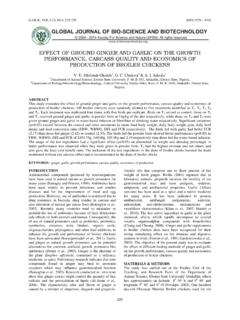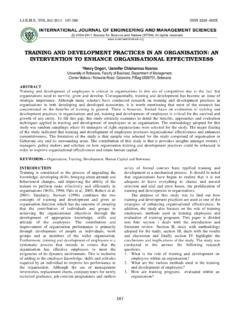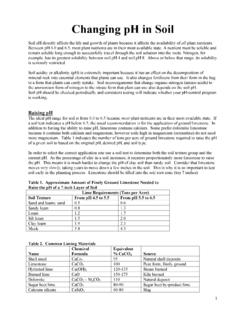Transcription of EVALUATION OF COMPLEMENTRY USE OF ... - …
1 , (3)2012:487-491 ISSN2250-3579487 EVALUATION OF COMPLEMENTRY USE OF ORGANIC ANDINORGANIC FERTILIZERS ON THE PERFORMANCE OF UPLAND RICE(Oryza sativaL.)1 Saidu. Adamu*,2 Abayomi, Yakeen .Abiola.,2 Aduloju, Morolake. Omolola1 Crop Production Department, Federal University of Technology, Minna, of Agronomy, University of Ilorin, Ilorin, field experiment was conducted at the National Cereals Research Institute Badeggi upland rice field to evaluate thecomplementary use of organic ( poultry dropping and cow dung) and inorganic fertilizers( urea) on the performance of ricecultivars. The experiment was arranged in a randomized complete block design(RCBD) with four replicates. The treatmentconsisted of three types of fertilizers (urea, cow dung, andpoultry dropping) which were used as sole and combined atdifferent rates. Application of 2kg of cow dung plus 260g N and 2kg of poultry dropping plus 260g N resulted in thehighest number of rice plant vigour while the rest applications did not show anysignificant difference.
2 There was nosignificant difference (p> ) in rice plant height at 30 DAS in almost all the plots except plot treated with 4kg of poultrydropping plus 173g N which recorded highest rice plant height. The application of 80kg N/haresulted in highest plantheight at 60 DAS and 90 DAS respectively. However, all fertilizer types and rates increased rice plant height highest number of tillers was observed at 30 DAS when 6kg of poultry dropping plus 86g N was applied while otherapplications did not show any significant (p> ) difference. The lowest number of tillers was recorded at 30 DAS, 60 DAS, and 90 DAS in plot where 2kg of cow dung plus 6 kg of poultry dropping was applied. The control recorded aappreciable number of tillers. There was no significant (p> ) difference in panicle length, the application of 2kg poultrydropping plus 260g N recorded highest panicle length while the lowest panicle was observed in control.
3 There was nosignificant (p> ) difference in panicle number. However, significant (p< ) difference was observed in grain application of 2kg poultry dropping plus 260g N recorded highest grain yield while lowest observed in , the application of 2kg poultry dropping plus 260g N to upland rice could be recommended could berecommended for optimal WORDS:Poultry dropping, cow dung, Nitrogen, Panicle length, Grain (Oryza sativaL.) is an important stable foodproviding 66-70 body calorieintakesof the is the need to heighten awareness of the role of ricein alleviating poverty and malnutrition (Barah and Pandy,2005).Nitrogen is typically the nutrient of most concernbecause it has strong influence on cereal crop yields. It ismostly abundantly found in the N2gaseous form, ofwhich is found in the earth s atmosphere Havlinet al.(2005). Nitrogen rate, type of nitrogen, and timing of itsapplication are important factors to increase wheat yieldGarrido Lestancheet al.
4 , (2005),Application of organic materials as fertilizers providesgrowth regulating substances and improvesthe physical,chemical and microbial properties of the soil Belayet al.,(2001). Several field research reports have indicated thathigh and sustainable crops yields are only possible withintegrated use of mineral fertilizer with organic manureSatyanarayanaet al., (2002). Complementary applicationof organic and inorganic fertilizers increase nutrientsynchrony and reduces lossesby converting inorganicnitrogen to organic forms Krameret al., (2002). The use oforganic and inorganic fertilizer has its advantages anddisadvantages in the content of nutrient supply, cropgrowth and environmental quality. The advantages need tobeintegrated in order to make optimum use of each typeof fertilizer and achieve balanced nutrient management forcrop of organic manures also improves the soilmicrobial properties Belayet al.
5 (2001). Growth andsustained crop yield could be obtained with judicious andbalanced NPK fertilization combined with organic manureamendments Makindeet al., (2001), Bayuet al., (2006).According to Guptaet al., (2004), the effect variesaccording to inherent physical and chemical properties ofthe soil,particularly on the nature and content. Alltogether, the use of organic manure helps in improvingsoil structure, soil aeration and therefore the activities ofthe soil micro-organisms (Olayinka and Ailenubhi, 2001).Dung contains the undigested portion of the feed eaten byanimals, whereas urine contains only soluble products andhas higher nitrogen and potassium contents than dung andsince these are in solution, they are quickly available toplant (Fagbenro, 2001). Long term use of cow-dungincrease aggregate stability, pore space, bulk density andavailability of water range Vanlauweet al.
6 , (2001).Greater amount of manure is obtained when applied insmall amounts and more often Vanlauweet al., (2001).Use of organic and inorganic fertilizers on the performance oforyza sativaL488 Cow dung applied with inorganic nitrogen (N), increasesoil (pH) and ameliorated acidity (Olayinka andAilenubhi, 2001).Mullens et. al., (2002) revealed that poultry litter containsa considerable amount of organic matter due to the manureand bedding material. Poultry manure improves soilphysical properties significantly by reducing soil bulkdensity, temperature, and increasing total soil porosity andmoisture content in Nigeria (Agbede et. al., 2008). InIndia, Amanullah et. al., (2007c) found that tuber yieldwas the highest with composted poultry manure followedby FYM plus CPM which was due to higher availability ofnutrients and uptake by the crop as influenced bycomposted poultry et. al., (2005) reported that complementaryapplication of rook phosphate with poultry manureincrease maize grain yield by 33% while cowpea yield wasincreased by 25%.
7 Buri et. al., (2004) in an experimentwith poultry manure, cattle manure and rice husk, appliedsingle or in combination with mineral fertilizer (using ureaor sulphate of ammonia as N source), found that acombination of half rate of organic amendment and halfrate of mineral fertilizer significantly contributed to thegrowth and yield of contrast to mineral fertilizer, poultry manure addsorganic matter to soil which improves soil structures,nutrient retention, soil moisture holding capacity, andwater infiltration (Deksissa et. al., 2008). It was alsoindicated that poultry manure moves readily, supplies P toplants than other organic manure sources (Gary and Bahla,2008).Most studies on the use of animal wastes dealt withcow dung and poultry droppings and their fertility-improving value has been confirmed for many crops(Akanbi 2002). The use of available and cheap cow dungby vegetable farmers in Nigeria ensure sustainability ofproduction and balanced nutrition as described by Moyin(2003).
8 Soils treated with farmyard manure were found tocontain enough soluble phosphoric acid, potash and lime(Palet al., 2001). The long term use of cow dungincreased aggregatestability, macro pores. Addition ofcow dung to soil lower bulk density (Olaniyanet al.,2006).MATRIALS&METHODSF ield experiment was conducted at National CerealsResearch Institute Badeggi upland rice field (LAT. , Long. , metres above sea level in southernGuinea Savanna ecological zone of Nigeria) to evaluatethe complementary use of organic and inorganic fertilizerson the performance of rice cultivars. Soil at the site wasrandomly sampled at two depths (0-15cm and 15-30cm)using soil auger before land preparation and afterharvesting of rice. The soil samples were analyzed for itsphysical and chemical characteristics. The soil of theexperimental site was sandy clay textured (USDA classification), characterized with was laid out in a randomized complete blockdesign with four replicates.
9 The treatments consisted offertilizer types and rates. The treatments imposed were8kgN/ha; cow dung at the rates of 8kgN/ha, 2kg/ha plus260gN/ha, 4kg/ha plus 173gN/ha, 6kg/ha plus 86gN/ha,and 2kg/ha cow dung plus 6kg/ha of poultry manure;poultry manure at the rates of 8kg/ha, 2kg/ha plus260gN/ha, 4kg/ha plus 173g N/ha, 6kg/ha plus 86g N/ha,and 2kg/ha poultry manure plus 6kg/ha cow dung; andcontrol plot where no fertilizer was applied. Fieldpreparation was by tractor after which seed beds eachmeasuring 4mx5m were manually prepared. Thetreatments ( cow dung and poultry manure at varyingrates) were incorporated into the soil prior to sowing ofrice seeds. Theseeds used was obtained from seeds unit ofNCRI Badeggi and were sown at the rate of four rice seedsper hill in July 2011. Fertilizer (urea) was split applied bybroadcasting method on the plots that were to receivefertilizer (urea) at 30 DAS, 60 DAS, andat booting plot was weeded twice ( 3 and 6 weeks after sowing)using native hoe.
10 Ten stands of rice plant were randomlyselected and tagged from each of the plot for datacollection. Data collected included plant vigour, plantheight(cm) and tiller count at 30, 60, and 90 DAS; lengthof central panicle(cm) and number of panicles atmaximum booting; grain yield (kg/ha). The rice washarvested in October 2011. Data collected were subjectedto analysis of heightThere was no significant difference(p> ) in Plantheight at 30 DAS in almost all the plots with exception ofplot treated with 4kg of poultry manure plus 173g N whichrecorded highest plant height(40cm) while the lowest plantheight(29cm) was observed in plot treated with 2kg ofpoultry manure plus 260gN. At 60 and 90 DAS significantdifference (p< ) was observed in all the highest plant height ( and ) wasobserved at 60 DAS and 90 DAS in plot treated with 8kgN/ha. However, all fertilizer types and rates increasedplant height of tillersThe numbers of tillers did not show significant difference(p> ) among the treatments at 30 DAS.















